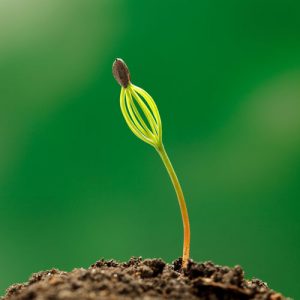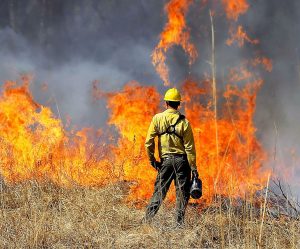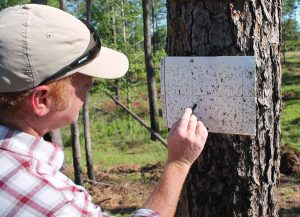Regardless of the objectives for a forested property, forest management evolves throughout the life cycle of a stand of trees and requires of its manager a diversified and experienced skill set that enables the delivery of a variety of management practices. The approach to forest management must be adaptive so that managers can implement the appropriate practice for a given stage in development and adjust to changing client objectives. The extensive background and level of experience at SFC allows managers to combine the art and science of forest management to produce the ultimate in forestland functionality for our clients.
Reforestation/Tree establishment
 Regardless of the investment, the foundation of any venture is critical to long-term success, and preliminary research and evaluation ensures that your investment is equipped to maximize performance. This is never more apparent than the decision to invest in a timber stand. The economics of growing timber require an assessment of the current and future market dynamics, but equally important are the biological characteristics that drive the majority of the initial planning stages.
Regardless of the investment, the foundation of any venture is critical to long-term success, and preliminary research and evaluation ensures that your investment is equipped to maximize performance. This is never more apparent than the decision to invest in a timber stand. The economics of growing timber require an assessment of the current and future market dynamics, but equally important are the biological characteristics that drive the majority of the initial planning stages.
Site specific factors including soil type, topography, hydrology, and local weather patterns guide decisions as to species selection, level of genetic improvement, site preparation technique, planting technique, density, and future management practices. By combining an understanding of tree silvics, site productivity, and local market tendencies, forestry consultants at SFC develop and implement comprehensive plans for long-term success.
Silvicultural Practices
The performance of a timber investment is predicated on a comprehensive reforestation process. However, the greatest foundation is worth little if the custodians of the asset do not maintain the timber stand throughout its life cycle. Of primary concern is the secondary vegetation, both desirable and undesirable, and the maintenance of the site’s productivity.
 Prescribed burning remains one of the most effective techniques in controlling unwanted vegetation that detracts from timber performance while simultaneously promoting numerous grasses, forbs, and legumes that are an essential source of food and cover for wildlife. Efforts to balance revenues from timber with recreational opportunities dependent on wildlife habitat should consider prescribed fire as an essential tool.
Prescribed burning remains one of the most effective techniques in controlling unwanted vegetation that detracts from timber performance while simultaneously promoting numerous grasses, forbs, and legumes that are an essential source of food and cover for wildlife. Efforts to balance revenues from timber with recreational opportunities dependent on wildlife habitat should consider prescribed fire as an essential tool.
The Certified Prescribed Burn Managers (CPMB) at SFC are experienced in developing long-term plans for implementing prescribed fire on the landscape. By rotating and varying the deployment of prescribed fire, SFC develops some of the most biodiverse habitats in the Southeast.
Herbicide Applications have developed as an increasingly common management practice as the expansion of urban centers and the subsequent interface of urban and wildland areas has limited the use of prescribed fire on many Southeastern landscapes. Many of the same outcomes sought from the implementation of prescribed fire can be realized through the use of selective herbicides. Whether your objectives require the control of undesirable vegetation, the promotion of herbaceous species, or a combination of both, the Licensed Pesticide Applicators at SFC are equipped to formulate the appropriate plan and technique.
Fertilization can be a crucial management component to maximizing the returns from a timber investment. Like all crops, timber is limited by many variables including moisture, competition for sunlight, and nutrients. Nutrient analysis in forested systems has made drastic advancements over the last several decades allowing managers to improve site productivity. Whether dealing with a major deficiency of a primary nutrient or simply needing a slight adjustment to a micronutrient, the forestry consultants at SFC are prepared to implement the necessary soil and foliar sampling required to develop a fertilization plan. Careful planning and implementation ensure that the appropriate amount of fertilization is administered to the site so that the secondary impacts to the system are minimized. Through the utilization of the latest research and technology, fertilization increases production while simultaneously protecting the ecosystem services commonly associated with forested landscapes.
Forest Health & Monitoring
 As a living investment, the biological health of a timber stand must be periodically evaluated to mitigate inherent risks from insect infestations, pathogens, colonization by invasive species, severe weather, wildfire, and others. The most effective way to reduce exposure to these risks is to utilize the aforementioned tools to ensure your timber is as healthy as possible. By controlling vegetation in the understory, maintaining appropriate timber stand densities, and reducing fuel loads that increase wildfire incidence, managers promote a healthy forest. This in turn, reduces stressors on the stand of timber allowing the individual trees that comprise the stand to fend off insects and pathogens that attempt to invade.
As a living investment, the biological health of a timber stand must be periodically evaluated to mitigate inherent risks from insect infestations, pathogens, colonization by invasive species, severe weather, wildfire, and others. The most effective way to reduce exposure to these risks is to utilize the aforementioned tools to ensure your timber is as healthy as possible. By controlling vegetation in the understory, maintaining appropriate timber stand densities, and reducing fuel loads that increase wildfire incidence, managers promote a healthy forest. This in turn, reduces stressors on the stand of timber allowing the individual trees that comprise the stand to fend off insects and pathogens that attempt to invade.
Should your timber stand succumb to an infestation of bark beetles, pathogens, or an invasive plant or animal species, SFC is equipped to address these issues promptly. At SFC, we employ the Integrated Pest Management approach to dealing with timber stand infestations. This method requires the consideration of numerous options, including mechanical, herbicidal, and biological measures, with the end goal of selecting the most effective and least impactful measures for implementation.
Native Vegetation Establishment and Restoration
Many landowners in the Southeast desire to combine return on investment with recreational, aesthetic, and wildlife benefits that improve the usability of their property. To achieve this multi-use objective, management of the ground cover is essential and often requires the restoration of native plant species that evolved to thrive on landscapes with frequent fire. SFC is equipped to implement native ground cover restoration from site preparation to post-establishment maintenance. We offer various planting techniques for establishing native ground cover in existing or new timber stands.
Learn more about Wiregrass Ecological Associates
Pine Straw Production
While timber production remains the key source of revenue for most timberland owners in the Southeast, the opportunity to sell pine straw has recently emerged as a realistic source of revenue generation, particularly for landowners in areas where the appropriate markets and contractors provide better pricing. The forestry consultants at SFC can provide guidance on the market structure for pine straw in your area. Cultivation of pine straw can be especially appealing to those landowners seeking annual cash flow generation and shorter rotation cycles for timber stands.